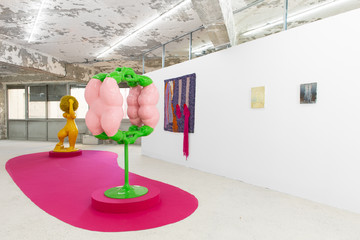Georg Kargl Fine Arts presents works by two distinctive and multi-layered artists: Jakob Lena Knebl and Mercedes Mangrané.
While Mercedes Mangrané’s works motivate a way of seeing that allows other forms and states to be perceived beyond what is currently visible, Jakob Lena Knebl’s installations elude clear-cut classifications, deliberately breaking with accustomed norms.
Jakob Lena Knebl’s expansive installations elude clear-cut classifications, deliberately breaking with accustomed norms. Having established a unique art-historically argumentative language that revolves around questions of corporeality, her work crosses boundaries between art, design, high and low culture, which echoes the fluid movements of identity. Knebl’s work engages with historical references, reimagining them in new ways, to consider how we construct meaning in our present. The artist’s current interrogation of sociopolitical issues and art and design of the 1970s, reflects its lasting influence on the present day. Key aspects in this context include the construction of identity as an infinitely malleable process and the question of co-producers and mechanisms of exclusion. Her sculptures are assembled as intersections of body fragments, consisting of various objects and materials. These designed objects are structures of self-empowerment, as well as embodiments of an inescapable desire, that pushes into visibility and alters the (surrounding) world.
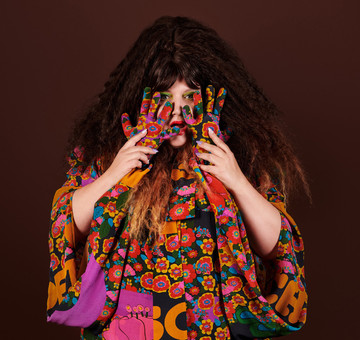
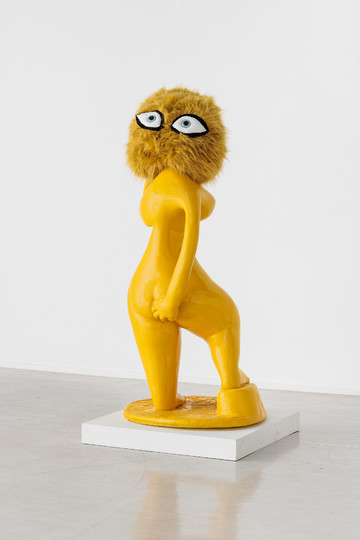
Polyethane, cast resin, artificial eyes, plush
160 x 80 x 55cm
“Coloured settings are a no go in modernism, the materials stone and bronze are regarded as binding because they are resistant and imperishable. Moreover, sculpture is unquestionably a male discipline. Knebl exchanges heads and bodies, for her shaggy creature also the material. Not only is the questionable image of the modern woman recalled, in the 3D print the figure proves to be a conglomerate and a copy. Art is chiroplastic. Gender and genes, bad taste and museum art merge. The fixed point of an identity is lost in the gimmick. What applies to the essence, the diversity, also applies to its parts. … The cliché of the classical nude figure becomes a transgender configuration …”
Thomas D. Trummer, published in Softmachine, Biennale Arte 2022
Paraphrasing “La grande baigneuse” (1947) by Henri Laurens, Knebl modifies in OF2 its pose adding a cheeky gesture and a furry 1970s Glook Gonk big-eyed toy head.
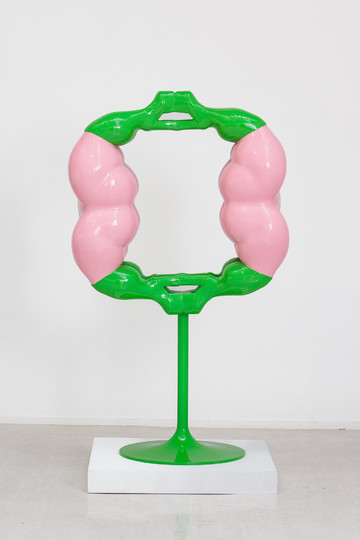
Polyethane, cast resin
160 x 150 x 100 cm
Knebl’s OF3 refers to Botero as well as the design classic “Tulip Stool” by Eero Saarinen and the 1970s platform boots. In this context, Knebl focuses on identity and the possibilities of its transformation, the places in which it is staged, and the question of co-producers and exclusion mechanisms.
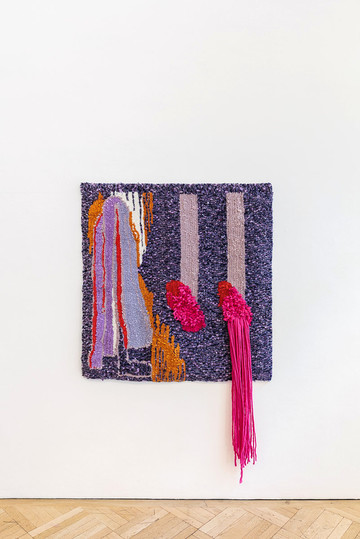
hand-tufted wool, latex
130 x 130 cm
Tapestry, a recurring object in Knebl’s environments and scenographies, represents a turning point: while the term Applied Art is still tangible here and follows the pure surface of style history, the implementation is of socio-theoretical relevance and part of cultural and social history.

C-print
80 x 120 cm
The title of this photograph gives reference to a very special sofa type originally manufactured in England. By taking over the structure of this piece of furniture and applying it on the artist’s body, Knebl not only becomes the art piece but plays with gender and other subjects, the artist refers to the conundrum of being trapped in and modeled by body conventions without any escape. In addition, the fact that this type of sofa is mainly used in ‘gentlemen’s clubs’ addresses the role of women as a ‘comfort zone’ or ‘convenience’ for men. The artist critically questions the construction of identity, referring to both gender and social issues. The visualization of different discourses, such as body norms, taboos, and culture as a process of copying or assimilation can be considered the foundation of her artistic approach.
Jakob Lena Knebl (*1970) lives and works in Vienna.
Current exhibition: Doppelganger, with Ashley Hans Scheirl, Palais de Tokyo, Paris (2023)
Recent selected solo exhibitions: Invitation of the Soft Machine and Her Angry Body Parts, Austrian Pavillion, 59th Venice Biennale, Venice (2022); Soft Machine, Phileas, Vienna (2022); Walk on Water, MAH Musée d´art et d´histoire, Geneva (2021); Seasonal Greetings, Kunsthaus Bregenz, Bregenz (2020)
Upcoming: Deichtorhallen, Hamburg (2024)
Recent group exhibitions: Re-Inventing Piet. Mondrian und die Folgen, Kunstmuseum, Wolfsburg (2023); Empowerment, Kunstmuseum Wolfsburg, Wolfsburg (2022); the other world, the world of the teapot. tenderness, a model, Kestner Gesellschaft, Hannover (2022).
“My relationship with paintings is above all intuitive, there is an important connection between chance and control, it is not a precision painting but one in which I try to make things happen. If paintings are understood as an object, it obeys the laws of material culture but has an intangible part, a part in which what is not present or what is not graspable is evoked. there is an inevitably mundane starting ground. in which I start from my immediate environment but do not try to approach it literally but from the evocation.”
Mercedes Mangrané (2020)
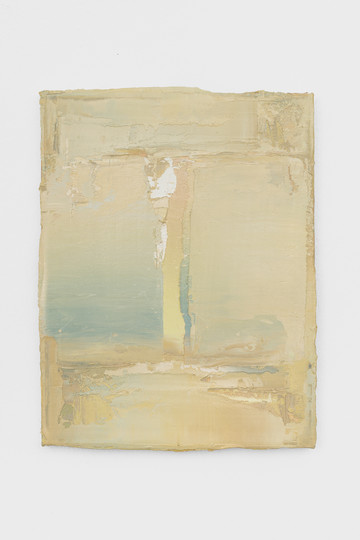
oil on canvas
35 x 27 cm
Mercedes Mangrané’s body of work comprises paintings, collages, videos, and sculptures. Mangrané examines, through a varied use of materials, the embeddedness of art history and cultural production within the practice of everyday life, informed by an attentive research process incorporating the study of artifacts and protocols within museum collections. The small-scale format of the works emerges from a desire that seeks the proximity of the viewer and a lingering engagement with the senses, in a suspended moment of experience. Her paintings demand slowness of the gaze because their own making, and their own construction are also slow and timely. By traversing both the lightness and density of material, Mangrané engages a dialectic between instances of everyday occurrence and systems of cultural power, that reflects on the movements amidst finitude and transformation, form and formlessness.
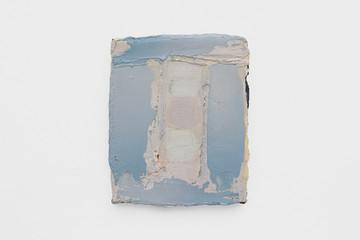
oil on canvas
29 x 23,5 cm
“I start from small formats, partly because the body asks me to, it’s the best solution I have found so far, a matter of scale with the body itself. Also the themes of my paintings depart from a non-specified origin, they are quite ambiguous even though they start from the world, they deal with banality, marginal things, the space we inhabit (not always within the dichotomic logic of the inside-outside… but the interstice)… hence the small format has an affinity with the unspectacular.”
Mercedes Mangrané (2020)
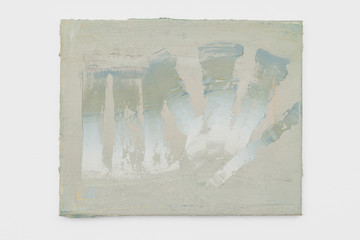
oil on canvas
33 x 40 cm
Mercedes Mangrané (*1988 in Barcelona, lives and works in Barcelona)
Solo exhibitions: Gravities, Georg Kargl BOX, Vienna (2023)
Selected exhibitions: Let’s meet under a cloud of freedom, Artphilein Foundation, Lugano (2021); Asir, Museo Patio Herreriano, Valladolid (2019); Notes on Landscape, Kunstraum Lakeside, Klagenfurt (2019); Susceptible, Cultural Rizoma Celrà, Girona (2019); Flirteo, Botanical Garden, Barcelona (2018); Mardel Visual Arts, Centre Cultural Carme, Valencia (2018); amongst others.
Upcoming: La estética del silencio / The aesthetics of silence, Galeria MAP, Madrid

